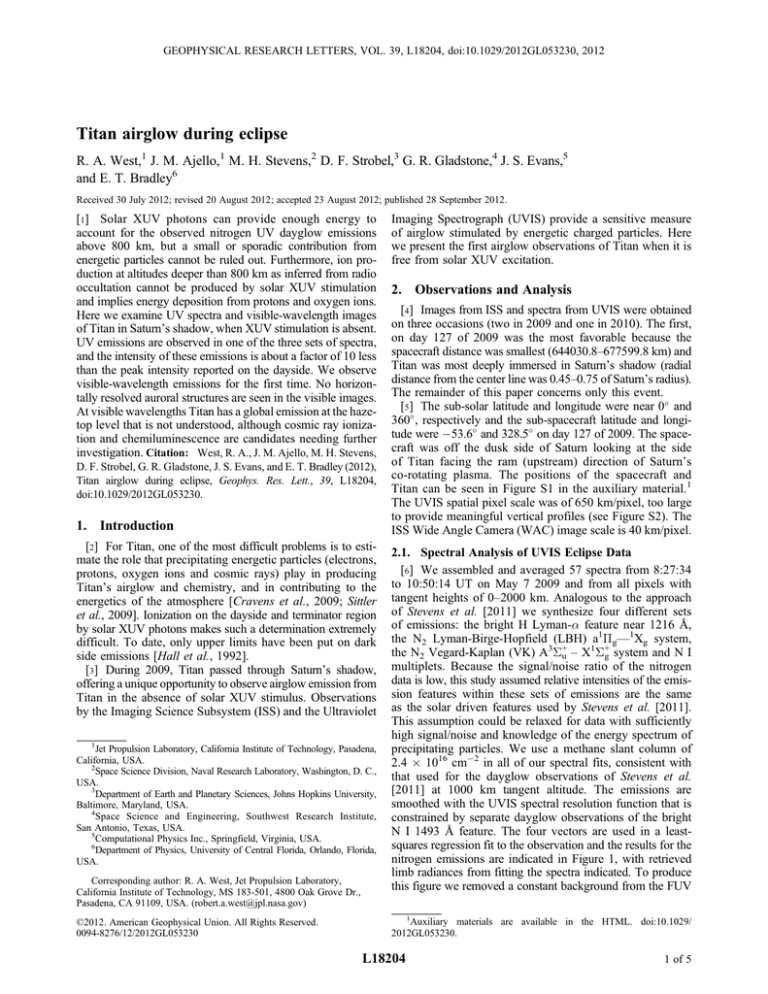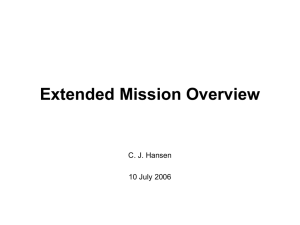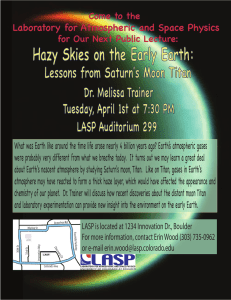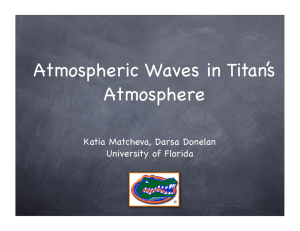
GEOPHYSICAL RESEARCH LETTERS, VOL. 39, L18204, doi:10.1029/2012GL053230, 2012
Titan airglow during eclipse
R. A. West,1 J. M. Ajello,1 M. H. Stevens,2 D. F. Strobel,3 G. R. Gladstone,4 J. S. Evans,5
and E. T. Bradley6
Received 30 July 2012; revised 20 August 2012; accepted 23 August 2012; published 28 September 2012.
[1] Solar XUV photons can provide enough energy to
account for the observed nitrogen UV dayglow emissions
above 800 km, but a small or sporadic contribution from
energetic particles cannot be ruled out. Furthermore, ion production at altitudes deeper than 800 km as inferred from radio
occultation cannot be produced by solar XUV stimulation
and implies energy deposition from protons and oxygen ions.
Here we examine UV spectra and visible-wavelength images
of Titan in Saturn’s shadow, when XUV stimulation is absent.
UV emissions are observed in one of the three sets of spectra,
and the intensity of these emissions is about a factor of 10 less
than the peak intensity reported on the dayside. We observe
visible-wavelength emissions for the first time. No horizontally resolved auroral structures are seen in the visible images.
At visible wavelengths Titan has a global emission at the hazetop level that is not understood, although cosmic ray ionization and chemiluminescence are candidates needing further
investigation. Citation: West, R. A., J. M. Ajello, M. H. Stevens,
D. F. Strobel, G. R. Gladstone, J. S. Evans, and E. T. Bradley (2012),
Titan airglow during eclipse, Geophys. Res. Lett., 39, L18204,
doi:10.1029/2012GL053230.
1. Introduction
[2] For Titan, one of the most difficult problems is to estimate the role that precipitating energetic particles (electrons,
protons, oxygen ions and cosmic rays) play in producing
Titan’s airglow and chemistry, and in contributing to the
energetics of the atmosphere [Cravens et al., 2009; Sittler
et al., 2009]. Ionization on the dayside and terminator region
by solar XUV photons makes such a determination extremely
difficult. To date, only upper limits have been put on dark
side emissions [Hall et al., 1992].
[3] During 2009, Titan passed through Saturn’s shadow,
offering a unique opportunity to observe airglow emission from
Titan in the absence of solar XUV stimulus. Observations
by the Imaging Science Subsystem (ISS) and the Ultraviolet
1
Jet Propulsion Laboratory, California Institute of Technology, Pasadena,
California, USA.
2
Space Science Division, Naval Research Laboratory, Washington, D. C.,
USA.
3
Department of Earth and Planetary Sciences, Johns Hopkins University,
Baltimore, Maryland, USA.
4
Space Science and Engineering, Southwest Research Institute,
San Antonio, Texas, USA.
5
Computational Physics Inc., Springfield, Virginia, USA.
6
Department of Physics, University of Central Florida, Orlando, Florida,
USA.
Corresponding author: R. A. West, Jet Propulsion Laboratory,
California Institute of Technology, MS 183-501, 4800 Oak Grove Dr.,
Pasadena, CA 91109, USA. (robert.a.west@jpl.nasa.gov)
©2012. American Geophysical Union. All Rights Reserved.
0094-8276/12/2012GL053230
Imaging Spectrograph (UVIS) provide a sensitive measure
of airglow stimulated by energetic charged particles. Here
we present the first airglow observations of Titan when it is
free from solar XUV excitation.
2. Observations and Analysis
[4] Images from ISS and spectra from UVIS were obtained
on three occasions (two in 2009 and one in 2010). The first,
on day 127 of 2009 was the most favorable because the
spacecraft distance was smallest (644030.8–677599.8 km) and
Titan was most deeply immersed in Saturn’s shadow (radial
distance from the center line was 0.45–0.75 of Saturn’s radius).
The remainder of this paper concerns only this event.
[5] The sub-solar latitude and longitude were near 0 and
360 , respectively and the sub-spacecraft latitude and longitude were 53.6 and 328.5 on day 127 of 2009. The spacecraft was off the dusk side of Saturn looking at the side
of Titan facing the ram (upstream) direction of Saturn’s
co-rotating plasma. The positions of the spacecraft and
Titan can be seen in Figure S1 in the auxiliary material.1
The UVIS spatial pixel scale was of 650 km/pixel, too large
to provide meaningful vertical profiles (see Figure S2). The
ISS Wide Angle Camera (WAC) image scale is 40 km/pixel.
2.1. Spectral Analysis of UVIS Eclipse Data
[6] We assembled and averaged 57 spectra from 8:27:34
to 10:50:14 UT on May 7 2009 and from all pixels with
tangent heights of 0–2000 km. Analogous to the approach
of Stevens et al. [2011] we synthesize four different sets
of emissions: the bright H Lyman-a feature near 1216 Å,
the N2 Lyman-Birge-Hopfield (LBH) a1Pg—1Xg system,
the N2 Vegard-Kaplan (VK) A3S+u – X1S+g system and N I
multiplets. Because the signal/noise ratio of the nitrogen
data is low, this study assumed relative intensities of the emission features within these sets of emissions are the same
as the solar driven features used by Stevens et al. [2011].
This assumption could be relaxed for data with sufficiently
high signal/noise and knowledge of the energy spectrum of
precipitating particles. We use a methane slant column of
2.4 1016 cm 2 in all of our spectral fits, consistent with
that used for the dayglow observations of Stevens et al.
[2011] at 1000 km tangent altitude. The emissions are
smoothed with the UVIS spectral resolution function that is
constrained by separate dayglow observations of the bright
N I 1493 Å feature. The four vectors are used in a leastsquares regression fit to the observation and the results for the
nitrogen emissions are indicated in Figure 1, with retrieved
limb radiances from fitting the spectra indicated. To produce
this figure we removed a constant background from the FUV
1
Auxiliary materials are available in the HTML. doi:10.1029/
2012GL053230.
L18204
1 of 5
L18204
WEST ET AL.: TITAN AIRGLOW DURING ECLIPSE
L18204
indicated is also about a factor of 15 weaker than the peak
dayglow radiance reported by Stevens et al. [2011]. Figure 1
(bottom) shows the contribution due to N I emission, which
is dominated by the N I 1200 Å and N I 1493 Å multiplets
and where the total N I emission is about a factor of 6 less
than the reported dayglow radiance.
[8] The airglow signal in the UVIS EUV channel is weak
so we limit our EUV analysis to wavelengths between
1000–1100 Å where the brightest features are identifiable.
In Figure 2 we use the same approach as for the FUV,
synthesizing the predominant features at high resolution and
then smoothing the spectrum with the UVIS spectral resolution function. We limit the analysis to three EUV features
or systems: the H Ly-b feature at 1026 Å, the N II 1085 Å
multiplet and the other weaker N I features. We use the
same column abundance of methane as we did with the
FUV (2.4 1016 cm 2). The contributions from H Ly b
(0.5 0.1 R) and N II 1085 Å (0.4 0.1 R) are indicated
with their associated fitting uncertainties. The N II 1085 Å
multiplet is about a factor of ten weaker than reported from
the dayglow observations [see Stevens et al., 2011].
Figure 1. (top) UVIS Titan FUV airglow data on 7 May
2009 between 8:27 and 10:50 UT while in Saturn’s shadow.
The composite fit to the data is overplotted in red and the
altitudes over which the data is averaged are indicated. (top
middle) Same as Figure 1 (top) but showing the component
of the fit from the N2 LBH bands Radiances and uncertainties from the fit over the wavelength region in Figure 1
(top) are indicated. (bottom middle) Same as Figure 1 (top
middle) but showing the component of the fit from the N2
VK bands instead. (bottom) Same as Figure 1 (top middle)
but only showing the component of the fit from the N I
features.
data that is of the order 0.03 R/Å, most likely due to an
unknown broadband emission source.
[7] Figure 1 (top) shows the data with the composite fit
over-plotted. The three separate contributions from processes involving N2 to the composite fit are split out in the
three panels below. Radiances and uncertainties in Figures 1
(top middle), 1 (bottom middle), and 1 (bottom) are calculated over the entire fitted wavelength region, although the
spectral region in each panel is limited to where each set
of emissions is brightest. Figure 1 (top middle) shows the
contributions of the N2 LBH bands. The N2 LBH radiance is
about a factor of 15 less than the peak LBH limb radiance
reported from dayglow observations [Stevens et al., 2011].
It should be emphasized that the vertical resolution of the
dayglow observations was about a factor of ten higher than the
limb observations presented here. Figure 1 (bottom middle)
shows the contribution due to the N2 VK bands with the radiance and uncertainty also indicated. Although the VK (7,0)
band is discernable near 1689 Å, the total VK emission
2.2. The ISS Observations and Interpretation
[9] Twenty four WAC images were obtained using exposure times from 10 s to 560 s in broad-band filters from nearUV (315 nm) to near-IR (1000 nm), including the clear filters
covering the entire spectral range of the cameras [see Porco
et al., 2004]. We have images from the Narrow Angle Camera as well, but only the WAC (which has the faster optical
system) shows an airglow signal, with highest signal/noise
ratio in the [CL1,CL2] filter combination sensitive to light
from the violet (4000 Å) to near infrared (11000 Å).
Figure 3 shows one of the images (frame W1620383876).
[10] Three sources of illumination are evident in Figure 3.
In Figure 3a light refracted and scattered by Saturn’s high
atmosphere and by the rings illuminates the bottom portion of
the disk, producing I/F < 4 10 6, where I is the intensity
and pF is the solar flux at Titan. That is a factor of 2 10 5
weaker than Titan in direct sunlight at the same phase angle.
In Figure 3b that component has been subtracted using a
similarly-illuminated image in sunlight and what remains are
two components: Titan’s optically thick haze below 300 km
altitude illuminated by unknown sources (I/F 10 7), and a
very faint glow on the limb (I/F 2 10 8) in the optically
thin region between 300 km altitude (the inner dashed circle)
and 1000 km (the outer dashed circle).
Figure 2. UVIS Titan EUV airglow data while in Saturn’s
shadow. The composite fit to the data is overplotted in red
and the altitudes over which the data is averaged are the
same as in Figure 1. The H Ly b and N II 1085 Å radiance
is indicated with the fitted uncertainty.
2 of 5
L18204
WEST ET AL.: TITAN AIRGLOW DURING ECLIPSE
Figure 3. Two views of image W1620383876, a 560 s exposure in the [CL1,CL2] (clear) filter combination. (a) Brightness
is proportional to intensity, with maximum I/F = 4 10 6.
The direction to Saturn is downward. Background star trails
and cosmic ray events are apparent. (b) Light from Saturn’s
limb and rings has been subtracted by using an image in sunlight at nearly the same phase angle, and intensity scaled
to maximum I/F = 2 10 7. A latitude/longitude grid has
been placed on the image showing the location of the south
pole. The dashed circles in Figure 4b are located at 300 km
and 1000 km altitude.
[11] We examined the possibility that Hyperion, Iapetus
and Phoebe might be sources of illumination for Titan’s antisun hemisphere. The sub-Titan meridians of Hyperion and
Iapetus are about 90 degrees or more from the Cassini
meridian. They would produce a crescent of illumination on
the right side of Titan in Figure 3b, leaving the left side in
shadow. That is not what is seen. The part of Titan’s disk
beyond the terminator (from Saturn shine) is left/right symmetric. The asymmetric portion of the disk is less reliable
because a relatively large component was subtracted and the
small residual is subject to error (such as a centering error or
latitudinal gradients in the subtracted image not matching
those in the eclipse image). Phoebe-shine is too weak by
four orders of magnitude.
[12] Internal sources of illumination must also be evaluated for the source of light at the haze level. Cosmic rays
penetrate to deep levels. Ionization and subsequent airglow
emission from that process may contribute. Lightning is
not a candidate [see Fischer and Gurnett, 2011]. Chemiluminescence from a long-lived excited state produced on
the dayside and advected to the night side is a possibility.
For example, Titan’s ionosphere is dominated by HCNH+,
which is a terminal ion. Assuming an ionosphere density
of 1000 cm 3 at an electron temperature of 1000 K over
an altitude range of 1000 km [cf. Cravens et al., 2009],
the electron recombination reaction HCNH+ + e → CN+ H2
could yield 13 R of near-UV to visible CN emissions
L18204
(assuming a recombination rate of 2.8E-7(300/T)0.65 and a
yield of 33% for this path [Semaniak et al., 2001]). Finally,
emissions produced by energetic protons or oxygen ions
precipitating from Saturn’s magnetosphere may be responsible for the much weaker intensity in the optically thin
region above 600 km. They are not expected to be significant sources below 300 km [Cravens et al., 2008, 2009].
[13] The weak signal between 300 and 1000 km altitude is
very close to the noise level. The signal persists in deconvolved images, allowing us to rule out as its origin a convolution of the camera point spread function (PSF) with the
brighter part of the disk. The signal is nearly uniform with
location around the limb (about equal beyond the terminator
as on the sun-facing side), unlike what would be produced
by a convolution of the asymmetric solar illumination with
the camera PSF. The signal is nearly uniform with altitude
between 300 and 1000 km altitude. Magnetospheric electrons do not penetrate below about 800 km and so the energy
source may be precipitating protons or oxygen ions [Cravens
et al., 2008, 2009].
[14] A faint limb signal similar to that shown in Figure 3b
is seen in ISS broadband filter images from blue (central
wavelength 4510 Å) to IR2 (8620 Å). Emissions were not
detected in the WAC violet filter (4200 Å) or the IR3 filter
(9300 Å). We had hoped to compare filter observations with
the predictions for electron impact [Mangina et al., 2011]
but the signal/noise ratio of the observations was not sufficiently high for that purpose.
3. Hydrogen Emissions
[15] Although Titan experiences no direct EUV solar
illumination while in Saturn’s shadow, interstellar H atoms
redirect the Sun’s flux of Lya photons via resonance scattering to produce a roughly uniform glow of interplanetary
(IPM) Lya emission. During the eclipse observations, UVIS
observed Titan with the upstream (l = 252 , b = 8.9
[Lallement et al., 2010]) IPM in the background, so that the
sub-Cassini point on the eclipsed disk of Titan was illuminated by the downstream hemisphere of the sky. We model
the scattering of IPM Lya in Titan’s atmosphere (P. Hedelt,
private communication, 2011) using the resonance line radiative transfer code of Gladstone et al. [2004]. Based on
models [Pryor et al., 2012] we take the IPM Lya source
present at Titan to be uniform at 250 R brightness, with a
Gaussian line profile appropriate for an IPM H temperature
of 12,000 K [Izmodenov, 2009], with a Doppler redshift of
22cos(zenith angle) [in km/s]. We approximate the IPM
illumination in 10 -wide zenith angle annuli, and sum the
results to obtain the total emission rate. Details are shown in
Figure S3.
[16] The model predicts 23 R of Lya emission from the
sub-Cassini region of Titan. This is roughly half of what
is observed in the UVIS spectrum. The observations show
41.9 1.6 R of emergent Ly a emission from Titan’s disk
during these observations. The remaining 19 R may be produced by charge exchange with impacting protons, a strong
excitation process of Lya observed in the laboratory [Ajello
et al., 2011] with a small contribution from the IPM along
the line of sight from the spacecraft to Titan. This residual
19 R emission source is most probably due to precipitating
protons because according to Strickland et al. [1993] the yield
of Lya to total LBH photons in terrestrial proton auroras
3 of 5
L18204
WEST ET AL.: TITAN AIRGLOW DURING ECLIPSE
is 1–2, depending on incident proton energies and after
cross section adjustments discussed in Correira et al. [2011].
From the observed intensity of the detected LBH bands in
Figure 1 (top) (7.2 5.1 R), we would therefore expect the
emergent Lya intensity to be 25–50 R due to both an
interplanetary contribution and proton excitation. We know
that both H and O ions are present in Saturn’s magnetosphere [e.g., Cravens et al., 2008] and this would permit an
admixture of precipitating protons and O+ ions. Magnetospheric electron production of Lya by H2 dissociative excitation would be negligible because most of the electron
energy would be deposited below the exobase where H2 is a
minor constituent, as is H.
4. Discussion
[17] One of the important scientific objectives of the
Cassini Mission is to determine the relative contributions of
magnetospheric energy and solar energy inputs to Titan’s
upper atmosphere. From the FUV airglow measurements in
eclipse reported here with intensities an order of magnitude
lower than in the FUV dayglow, the direct inference would
be that solar input is approximately a factor of ten more
important than magnetospheric input. The fact that both the
N II 1085 Å and the N I multiplets are about a factor of six to
ten weaker than in the dayglow [Stevens et al., 2011] implies
that most magnetospheric FUV emission is produced above
the CH4 t = 1 level or 850 km. According to Cravens et al.
[2008] lower energy (<30 keV) oxygen ions and protons
would deposit most of their energy above this level.
[18] With better S/N and detailed model plasma calculations beyond the scope of this letter, diagnosing the nature of
the precipitating particles and their energy spectrum from the
airglow of Titan would allow us to quantify the interaction
between Saturn’s magnetosphere and Titan’s upper atmosphere. Simulating the relative intensity of the observed
emission features with a model that contains all the relevant
excitation processes by electrons, protons and O+ is the
means by which this can be done. Although the N2 LBH and
VK bands are the two brightest systems in Titan’s UV airglow, the relative intensities of the individual emission features are subject to uncertainties in yields from electron,
proton and ion impact as well as uncertainties in cascade
contributions to N2 LBH and VK bands from higher lying
states [Eastes, 2000; Ajello et al., 2010; Correira et al.,
2011; Stevens et al., 2011; Bhardwaj and Jain, 2012]. The
most useful diagnostics for deriving the incident energy
spectrum are the features arising directly from electron,
proton and ion impact with N and/or N2 (e.g., N II 1085 Å
and N I 1493 Å), which are not subject to cascade contributions. Additionally, valuable new insight can be gained
through limb observations with higher vertical resolution
over the extensive ionosphere from 500–1400 km than what
is shown here to locate the peak altitude of the precipitating
particles and thereby constrain their characteristic energy.
Unfortunately methane absorption blocks emission below
800 km except for strong features above 1400 Å wavelength
indicating a high S/N observation of 1493 Å, is an ideal
candidate. The distant FUV eclipse data reported indicate the
magnetosphere energy input to be a minor source (10%) of
globally averaged energy input to Titan’s upper atmosphere.
L18204
[19] Acknowledgments. We thank Pascal Hedelt who supplied tables
of H and CH4 densities in Titan’s atmosphere. DFS was supported by the
Cassini-Huygens Mission through JPL contract 109303. JMA and MHS
were supported by the NASA Cassini Data Analysis Program and Planetary
Atmospheres Program. RAW was supported by the Cassini-Huygens mission
and by the NASA Astrobiology Institute. Part of this work was performed
by the Jet Propulsion Laboratory, California Institute of Technology, under
a contract with the National Aeronautics and Space Administration.
[20] The Editor thanks Anil Bhardwaj and an anonymous reviewer for
assisting in the evaluation of this paper.
References
Ajello, J. M., R. S. Mangina, and R. R. Meier (2010), UV molecular spectroscopy from electron-impact for applications to planetary atmospheres
and astrophysics, in Charged Particle and Photon Interactions With Matter:
Recent Advances, Applications, and Interfaces, edited by Y. Hatano et al.,
chap. 28, pp. 761–804, Taylor and Francis, Boca Raton, Fla., doi:10.1201/
b10389-29.
Ajello, J. M., R. S. Mangina, D. J. Strickland, and D. Dziczek (2011), Laboratory studies of UV emissions from proton impact on N2: The LymanBirge-Hopfield band system for aurora analysis, J. Geophys. Res., 116,
A00K03, doi:10.1029/2010JA016103.
Bhardwaj, A., and S. K. Jain (2012), Production of N2 Vegard-Kaplan
and other triplet band emissions in the dayglow of Titan, Icarus, 218,
989–1005, doi:10.1016/j.icarus.2012.01.019.
Correira, J., D. J. Strickland, J. S. Evans, H. K. Knight, and J. H. Hecht
(2011), A downward revision of a recently reported proton auroral
LBH emission efficiency, J. Geophys. Res., 116, A07303, doi:10.1029/
2010JA016016.
Cravens, T. E., I. P. Robertson, S. A. Ledvina, D. Mitchell, S. M. Krimigis,
and J. H. Waite Jr. (2008), Energetic ion precipitation at Titan, Geophys.
Res. Lett., 35, L03103, doi:10.1029/2007GL032451.
Cravens, T. E., R. V. Yelle, J.-E. Wahland, D. E. Shemansky, and A. F.
Nagy (2009), Composition and structure of the ionosphere and thermosphere, in Titan From Cassini Huygens, edited by R. H. Brown, J.-P.
Lebreton, and J. H. Waite, chap. 11, pp. 259–295, Springer, Heidelberg,
Germany, doi:10.1007/978-1-4020-9215-2_11.
Eastes, R. W. (2000), Modeling the N2 Lyman-Birge-Hopfield bands in the
dayglow: Including radiative and collisional cascading between the
singlet states, J. Geophys. Res., 105(A8), 18,557–18,573, doi:10.1029/
1999JA000378.
Fischer, G., and D. A. Gurnett (2011), The search for Titan lightning radio
emissions, Geophys. Res. Lett., 38, L08206, doi:10.1029/2011GL047316.
Gladstone, G. R., W. R. Pryor, W. K. Tobiska, A. I. F. Stewart, K. E.
Simmons, and J. M. Ajello (2004), Constraints on Jupiter’s hydrogen
corona from Galileo UVS observations, Planet. Space Sci., 52, 415–421,
doi:10.1016/j.pss.2003.06.012.
Hall, D. T., D. E. Shemansky, and T. M. Tripp (1992), A reanalysis of
Voyager UVS observations of Titan, in Symposium on Titan, Eur. Space
Agency Spec. Publ., ESA, SP-338, 69–74.
Izmodenov, V. V. (2009), Local interstellar parameters as they are inferred
from analysis of observations inside the heliosphere, Space Sci. Rev.,
143, 139–150, doi:10.1007/s11214-008-9444-y.
Lallement, R., E. Quemerais, D. Koutroumpa, J.-L. Bertaux, S. Ferron,
W. Schmidt, and P. Lamy (2010), The interstellar H flow: Updated analysis of SOHO/SWAN data, in Twelfth International Solar Wind Conference, AIP Conf. Proc., 121, 555–558, doi:10.1063/1.3395925.
Mangina, R. S., J. M. Ajello, R. A. West, and D. Dziczek (2011), Highresolution electron-impact emission spectra and vibrational emission
cross sections from 330–1100 nm for N2, Astrophys. J. Suppl. Ser,
196, 13, doi:10.1088/0067-0049/196/1/13.
Porco, C., et al. (2004), Cassini imaging science: Instrument characteristics
and anticipated scientific investigations at Saturn, Space Sci. Rev., 115,
363–497, doi:10.1007/s11214-004-1456-7.
Pryor, W. R., G. M. Holsclaw, W. E. McClintock, M. A. Snow, R. J.
Vervack Jr., G. R. Gladstone, S. Alan Stern, K. D. Retherford, and
P. Miles (2012) Lyman-alpha Models for LRO LAMP from MESSENGER
MASCS and SOHO SWAN data, in Cross-Calibration of Past and Present
Far UV Spectra of Solar System Objects and the Heliosphere, ISSI Sci. Rep.,
vol. 12, edited by E. Quemerais, M. Snow, and R. M. Bonnet, in press.
Semaniak, J., B. F. Minaev, A. M. Derkatch, F. Hellberg, A. Neau, S. Rosén,
R. Thomas, and M. Larsson (2001), Dissociative recombination of
HCNH+: Absolute cross-sections and branching ratios, Astrophys. J.
Suppl. Ser., 135, 275–283, doi:10.1086/321797.
Sittler, E. C., R. E. Hartle, C. Bertucci, A. Coates, T. Cravens, I. Dandouras,
and D. Shemansky (2009), Energy deposition processes in Titan’s upper
atmosphere and its induced magnetosphere, in Titan From Cassini
Huygens, edited by R. H. Brown, J.-P. Lebreton, and J. H. Waite,
chap. 16, pp. 393–453, Springer, Heidelberg, Germany, doi:10.1007/
978-1-4020-9215-2_16.
4 of 5
L18204
WEST ET AL.: TITAN AIRGLOW DURING ECLIPSE
Stevens, M. H., et al. (2011), The production of Titan’s ultraviolet nitrogen
airglow, J. Geophys. Res., 116, A05304, doi:10.1029/2010JA016284.
L18204
Strickland, D. J., R. Daniell, J. Jasperse, and B. Basu (1993), Transport‐
theoretic model for the electron‐proton‐hydrogen atom aurora: 2. Model
results, J. Geophys. Res., 98(A12), 21,533–21,548, doi:10.1029/93JA01645.
5 of 5





